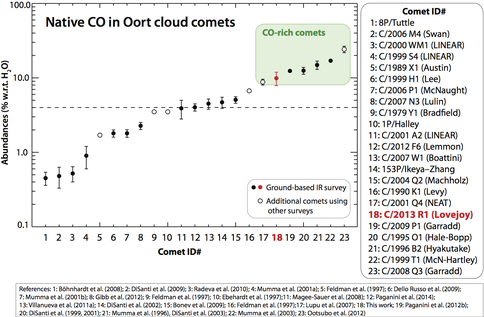2014 Annual Science Report
 NASA Goddard Space Flight Center
Reporting | SEP 2013 – DEC 2014
NASA Goddard Space Flight Center
Reporting | SEP 2013 – DEC 2014
The Variability of Carbon Monoxide Abundances Among Oort Cloud Comets
Project Summary
Direct observations of neutral CO in multiple wavelength regimes (radio, infrared and ultraviolet) have established a wide range for measured CO abundances (relative to water), ranging from a few tenths of a percent to ~30%. But the largest complexity when interpreting measurements of CO stems from its competing roles as a primary (parent) vs product species. For instance, CO is a principal product of CO2 dissociation, so comets rich in CO2 should also reveal a significant production rate for CO — this product CO is extended and its detection is strongly dependent on the instrumental field-of-view (FOV). Prior to 2013, only six comets within 2.5 AU of the Sun (where both H2O and CO are active primary volatiles) were identified as being enriched in native CO. During late 2013, we confirmed a relatively high abundance of CO in C/2013 R1 (Lovejoy; hereafter C/2013 R1), supporting the existence of a so-far sparse (yet growing) fraction of CO-rich comets.
Project Progress
Thanks to a combination of rapid-response observing strategies, technical advances, and a rigorous survey, we have quantified CO, H2O, and other volatile species in 17 Oort cloud comets since 1996, of which four were rich in native CO. With its measured CO abundance (~10%, relative to H2O), our observations identified comet C/2013 R1 (Lovejoy) as CO-rich — the fifth highest among the 17 comets from the ground-based IR survey. But can the relatively large CO content challenge and inform our current understanding of cometary origins?
Recent mapping of the solar-nebula analog TW Hydrae with ALMA allowed estimates of the CO frost line (near ~30 AU; Qi et al. 2013). Certainly, if we consider that the formation of comets occurred in the nebular mid-plane, a large CO abundance in these comets would support formation in cold regions near—or perhaps beyond—heliocentric distances that are consistent with the CO snowline. However, the possible roles of radial mixing, shielding of certain hyper-volatiles in water ice mantles, and the existence of diverse structural phases of ice, i.e. polar (H2O-rich) and apolar (CO-rich, CO2-rich), could serve as plausible explanations for the wide dispersion of CO content found in comets (see Paganini et al. 2012, ApJL, for a discussion).
Our identification of a new CO-rich comet has emphasized the need for continued observations of additional comets, to expand the sampled population and improve the statistics. These will test whether these comets stem from a larger population and, if so, assess whether the observed large CO abundance could indeed inform our understanding of the true formative conditions experienced by these icy bodies. Advancing our understanding of the dynamical delivery of cometary volatiles and refractory organics to the young Earth is a key goal of our NAI Team, and establishing the true taxonomy for comets based on composition is critical to that understanding.
Publications
-
DiSanti, M. A., Villanueva, G. L., Paganini, L., Bonev, B. P., Keane, J. V., Meech, K. J., & Mumma, M. J. (2014). Pre- and post-perihelion observations of C/2009 P1 (Garradd): Evidence for an oxygen-rich heritage?. Icarus, 228, 167–180. doi:10.1016/j.icarus.2013.09.001
-
Paganini, L., DiSanti, M. A., Mumma, M. J., Villanueva, G. L., Bonev, B. P., Keane, J. V., … Meech, K. J. (2013). THE UNEXPECTEDLY BRIGHT COMET C/2012 F6 (LEMMON) UNVEILED AT NEAR-INFRARED WAVELENGTHS. The Astronomical Journal, 147(1), 15. doi:10.1088/0004-6256/147/1/15
-
Paganini, L., Mumma, M. J., Villanueva, G. L., Keane, J. V., Blake, G. A., Bonev, B. P., … Meech, K. J. (2014). C/2013 R1 (LOVEJOY) AT IR WAVELENGTHS AND THE VARIABILITY OF CO ABUNDANCES AMONG OORT CLOUD COMETS. The Astrophysical Journal, 791(2), 122. doi:10.1088/0004-637x/791/2/122
-
PROJECT INVESTIGATORS:
-
PROJECT MEMBERS:
Lucas Paganini
Project Investigator
Michael Mumma
Co-Investigator
Geoffrey Blake
Collaborator
Boncho Bonev
Collaborator
Michael DiSanti
Collaborator
Erika Gibb
Collaborator
Jacqueline Keane
Collaborator
Karen Meech
Collaborator
Geronimo Villanueva
Collaborator
-
RELATED OBJECTIVES:
Objective 1.1
Formation and evolution of habitable planets.
Objective 3.1
Sources of prebiotic materials and catalysts
Objective 3.2
Origins and evolution of functional biomolecules
Objective 7.1
Biosignatures to be sought in Solar System materials
